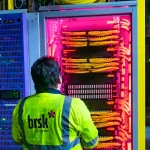Ulster University Uses AI to Develop Faster MIMO Tech for 6G Mobile

Researchers working out of Ulster University in Northern Ireland (UK) have harnessed AI (Artificial Intelligence) in order to develop a new type of Massive Multiple-Input Multiple-Output (ma-MIMO) technology. The team say this could be used to make future 6G (IMT-2030) based mobile broadband networks “faster, smarter, and far more energy-efficient“.
At present the 6G standard is still in the early R&D phase and most observers don’t expect to see the first commercial network builds surfacing until around 2030 (note: some countries do expect early field trials around 2028). Suffice to say that a lot of work is currently ongoing to help produce the final standard and develop prototype solutions.
One of the areas that researchers hope to improve upon is Massive MIMO technology, which harnesses multiple antennae to send and receive data more efficiently to lots of users (both at the mobile mast and on your Smartphone / mobile router / IoT device etc.).
Advertisement
The latest innovation on this front, known as MIMONet, is the work of Ulster University PhD researcher Yunis Daha in the School of Engineering, supervised by Dr Usman Hadi. Published in the journal Telecom, the research tackles one of the most urgent challenges in global wireless communication: how to detect and process signals accurately and efficiently when millions of devices are connected simultaneously.
Traditional methods for MIMO detection either struggle to deliver accuracy or require enormous computational power, making them impractical for real-time use. MIMONet seeks to overcome this by applying a “lightweight deep learning architecture that can “learn” to separate and detect signals even under the most complex and noisy conditions“.
The result is a faster, more reliable and less power-hungry network in terms of hardware or energy.
Dr Usman Hadi, PhD Supervisor at Ulster University School of Engineering, said:
“6G will underpin technologies like autonomous transport, remote healthcare and immersive digital environments – but for these to work, networks need to process vast amounts of information quickly and reliably. This research shows how artificial intelligence can provide a practical solution, paving the way for communications that are both highly scalable and energy-efficient.”
Tests are said to show that MIMONet not only “outperforms traditional algorithms“, but also the most advanced AI-driven detectors currently in use – including AIDETECT, developed at Ulster University in 2023. But MIMONet delivers superior accuracy across small, medium and large network configurations while keeping computational demands low.
Advertisement
The focus here is really on improving 6G connectivity for applications that require ultra-reliable low-latency communications (URLLC), such as driverless cars, real-time medical robotics and future smart cities etc. But the work doesn’t work and the team are now looking at how they can expand MIMONet’s applicability to realistic 6G situations.
Further research on this technology will thus investigate its scalability to ultra-massive MIMO systems (such as 64 × 64 and 128 × 128), multi-user MIMO, and frequency-selective channels. Additionally, to improve generalisation, the team will use sophisticated training techniques, including transfer learning and data augmentation, and examine MIMONet’s resilience to non-Gaussian noise models (i.e. background noise that does not follow a standard Gaussian distribution).
Future work will also focus on federated learning for distributed MIMO, noncoherent detection, and a thorough examination of hardware-level performance and training complexity etc.
Mark is a professional technology writer, IT consultant and computer engineer from Dorset (England), he also founded ISPreview in 1999 and enjoys analysing the latest telecoms and broadband developments. Find me on X (Twitter), Mastodon, Facebook, BlueSky, Threads.net and Linkedin.
« LSBUD Finds UK Telecoms Industry Delivers 37.5% of Searches for Digging Work





















































Comments are closed